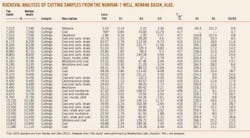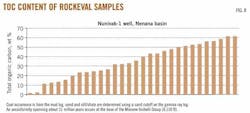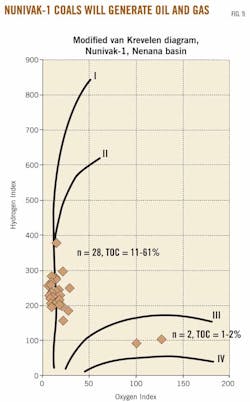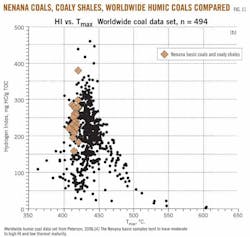Alaska's Interior rift basins: a new frontier for discovery
View Article as Single page
Source rocks
Identification and characterization of adequate hydrocarbon source rocks is critical for evaluating the hydrocarbon potential of a sedimentary basin and providing a rationale for further work. Surface outcrops provide useful information, but subsurface samples are free from surface alteration and oxidation and are likely more closely related to rocks in the basin center.
Table 1 shows RockEval analyses of cuttings from the Nunivak-1 well. Twenty-seven Late Paleocene samples below 8,110 ft are lithologically coal, coaly shale, or coaly siltstone. Total organic carbon varies from about 11% to 61% (average 38%, Fig. 8), and S2 peaks range from 27 to 189 mg HC/g org and average a remarkable 90 mg/g.
Hydrogen index (HI) ranges from 158 to 379 and averages 240. HI increases with depth in the well (Fig. 9), and eight samples of Late Paleocene rocks below 10,200 ft TVD have an average HI = 284.
On a modified van Krevelen diagram (Fig. 9), the coaly samples form a hydrogen-rich trend indicating potential to generate either oil or mixed oil and gas.
A Miocene siltstone (7,210 ft) and claystone (7,510 ft) plot midway between inert (Type IV) and gas-prone (Type III) in Fig. 9. Most of the coaly samples can be characterized geochemically as excellent oil-prone source rocks.3 The rich coal at 10,810 ft with TOC = 49.88% and HI = 379 highlights the potential for very attractive oil source rocks in deeper parts of the Nenana basin.
Fig. 10 shows visual estimates of kerogen composition in cuttings from Nunivak-1. Visual estimates in general confirm the geochemical results. Kerogen in the Nenana gravel is mostly Type III, whereas Type II predominates, sometimes strongly, in the Usibelli Group and Late Paleocene.
Coals and coaly shales from Nunivak-1 are compared with a worldwide dataset of more than 500 oil-prone humic coals4 in Fig. 11. Nenana basin coals have low maturity, as measured by Tmax, and moderate to high HI values. Based on this data set, Petersen4 estimates the effective oil window for Cenozoic oil-prone coals begins at Ro = 0.65. At this maturity, Petersen4 suggests Cenozoic oil-prone coals are saturated with hydrocarbons and oil expulsion begins.
Displaying 4/6
View Article as Single page






